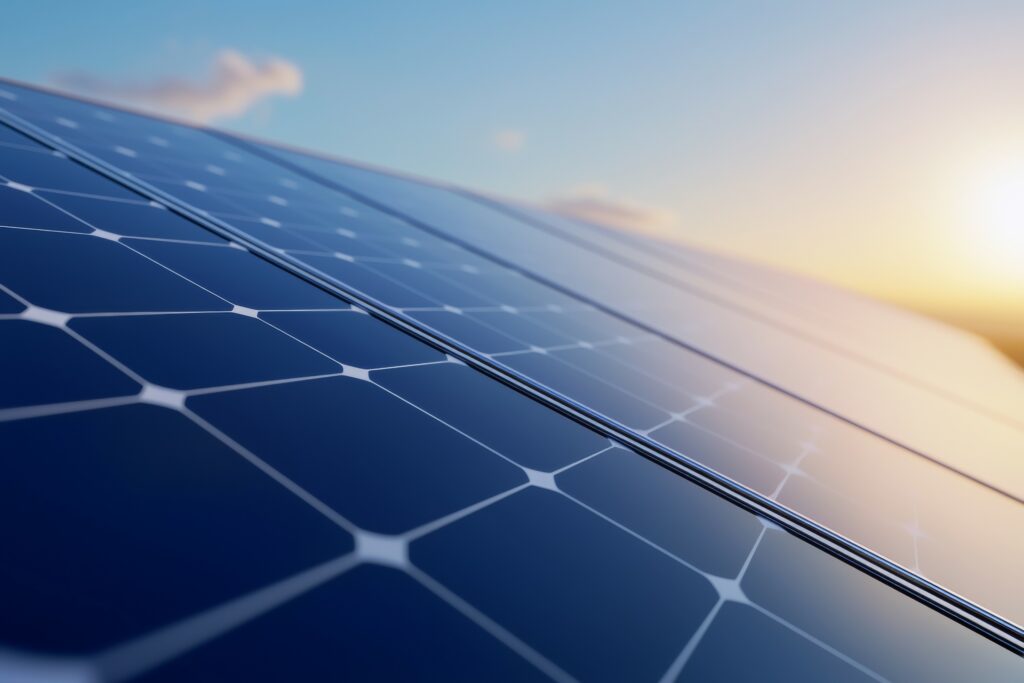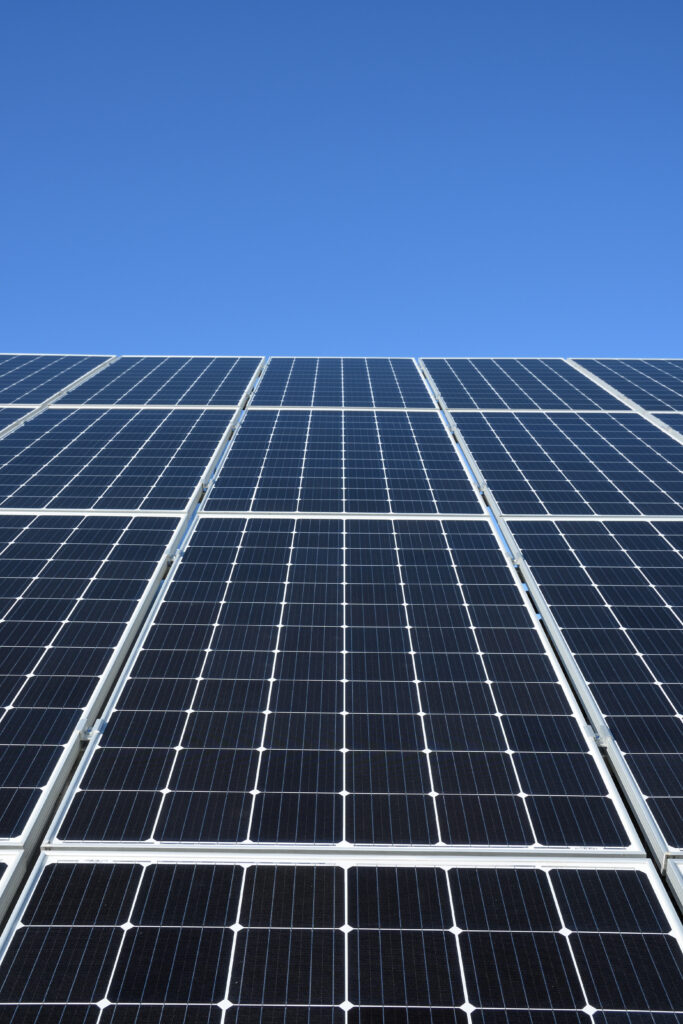



سولر پینلز نے انقلاب برپا کر دیا ہے کہ ہم سورج سے توانائی کیسے حاصل کرتے ہیں۔ اس ٹیکنالوجی کے مرکز میں فوٹو وولٹک خلیات ہیں، جو سورج کی روشنی کو بجلی میں تبدیل کرنے کے ذمہ دار ہیں۔ یہاں، ہم یہ سمجھنے کے لیے مرحلہ وار عمل کو توڑیں گے کہ یہ قابل ذکر آلات کیسے کام کرتے ہیں اور اس تناظر میں ڈائریکٹ کرنٹ (DC) جنریشن کی اہمیت کو اجاگر کریں گے۔
فوٹوولٹک سیلز کیا ہیں؟
فوٹو وولٹک خلیات سولر پینلز کے بلڈنگ بلاکس ہیں۔ یہ خلیے بنیادی طور پر سلکان سے بنائے گئے ہیں، ایک ایسا مواد جس میں برقی خصوصیات کی منفرد خصوصیات ہیں۔ جب سورج کی روشنی سیل پر حملہ کرتی ہے، تو یہ سلیکون میں موجود الیکٹرانوں کو اکساتی ہے، جس سے الیکٹران ہول کے جوڑے بنتے ہیں، جو بجلی پیدا کرنے کے لیے ضروری ہیں۔
ہر فوٹوولٹک سیل سلکان کی دو تہوں پر مشتمل ہوتا ہے: ایک تہہ فاسفورس کے ساتھ ڈوپ کی جاتی ہے، جو اسے منفی چارج (n-type silicon) دیتی ہے، جب کہ دوسری تہہ بوران سے ڈوپ ہوتی ہے، جو اسے مثبت چارج (p-type سلکان) دیتی ہے۔ یہ ان دو تہوں کے سنگم پر برقی میدان بناتا ہے۔
ڈی سی جنریشن کا عمل
- سورج کی روشنی کو جذب کرنا:
توانائی کی تبدیلی میں پہلا قدم اس وقت ہوتا ہے جب سورج کی روشنی سولر پینل کی سطح سے ٹکراتی ہے۔ سورج کی روشنی سے حاصل ہونے والی توانائی، فوٹوون کی شکل میں، سلکان فوٹوولٹک سیلز کے ذریعے جذب ہوتی ہے۔ - الیکٹران کا جوش:
جیسے جیسے فوٹوون جذب ہوتے ہیں، فوٹوولٹک خلیات کے ذریعے وہ اپنی توانائی کو سلیکون ایٹموں میں موجود الیکٹرانوں میں منتقل کرتے ہیں، جس کی وجہ سے کچھ الیکٹران پرجوش ہوجاتے ہیں اور اپنی معمول کی پوزیشن سے حرکت کرتے ہیں۔ یہ عمل الیکٹران ہول کے جوڑے بناتا ہے۔ - الیکٹرک فیلڈ کی تشکیل:
p-type اور n-type سلکان کی تہوں کے سنگم پر قائم الیکٹرک فیلڈ نئے آزاد الیکٹرانوں کو n-پرت کی طرف اور سوراخوں کو p-پرت کی طرف لے جاتی ہے۔ یہ حرکت برقی رو کا بہاؤ پیدا کرتی ہے۔ - کرنٹ کا مجموعہ:
شمسی خلیوں کے اطراف میں دھات کی ترسیلی پلیٹیں الیکٹرانوں کو جمع کرتی ہیں جو برقی میدان سے گزرتے ہیں اور انہیں ایک بیرونی سرکٹ میں لے جاتے ہیں۔ نتیجے میں پیدا ہونے والا کرنٹ ڈائریکٹ کرنٹ (DC) ہے۔ - انورٹر کی تبدیلی (اگر ضرورت ہو):
زیادہ تر گھریلو آلات اور گرڈ الٹرنیٹنگ کرنٹ (AC) پر کام کرتے ہیں، اس لیے پیدا ہونے والے DC کو AC میں تبدیل کرنے کی ضرورت ہے۔ یہ تبدیلی ایک آلے کا استعمال کرتے ہوئے کی جاتی ہے جسے انورٹر کہتے ہیں۔ - بجلی کا استعمال:
تبدیل شدہ بجلی یا تو فوری طور پر گھریلو ضروریات کے لیے استعمال کی جا سکتی ہے، بعد میں استعمال کے لیے بیٹریوں میں ذخیرہ کی جا سکتی ہے، یا پھر گرڈ میں فیڈ کی جا سکتی ہے۔
شمسی توانائی کے فوائد
شمسی توانائی بہت سے فوائد پیش کرتی ہے۔ یہ قابل تجدید ہے، بجلی کے بلوں کو نمایاں طور پر کم کرتا ہے، توانائی کی آزادی فراہم کرتا ہے، اور گرین ہاؤس گیسوں کے اخراج میں کمی میں معاون ہے۔ مزید برآں، شمسی ٹیکنالوجی میں پیش رفت کارکردگی کو بہتر بنانے اور لاگت کو کم کرتی رہتی ہے۔
نتیجہ
فوٹو وولٹک سیلز فوٹو وولٹک اثر کے ذریعے سورج کی روشنی کو براہ راست بجلی میں تبدیل کرکے کام کرتے ہیں، یہ عمل قابل تجدید توانائی ٹیکنالوجی کے لیے اہم ہے۔ جب سورج کی روشنی، جو فوٹون پر مشتمل ہوتی ہے، سیمی کنڈکٹر مواد پر حملہ کرتی ہے-عام طور پر سلکان-پی وی سیل کے اندر، یہ توانائی الیکٹرانوں کو منتقل کرتی ہے، انہیں ایٹموں سے آزاد کرتی ہے اور برقی چارج بناتی ہے۔ الیکٹرانوں کی یہ حرکت براہ راست کرنٹ (DC) بجلی کا بہاؤ پیدا کرتی ہے، جسے سولر پینلز میں سرایت شدہ وائرنگ کے ذریعے پکڑا جاتا ہے۔
فوٹوولٹک خلیات کی ساخت میں سلیکون کی پرتیں شامل ہوتی ہیں جن کا علاج ایک مثبت (p-type) اور ایک منفی (n-type) خطہ بنانے کے لیے کیا جاتا ہے، جس سے ان کے جنکشن پر برقی میدان بنتا ہے۔ یہ برقی میدان ایک ڈائیوڈ کے طور پر کام کرتا ہے، آزاد الیکٹرانوں کو ایک سمت میں بہنے پر مجبور کرتا ہے، اس طرح ایک مستحکم ڈی سی کرنٹ پیدا ہوتا ہے۔ سیل پر دھاتی رابطے ان الیکٹرانوں کو جمع کرتے ہیں اور انہیں ایک بیرونی سرکٹ کے ذریعے چلاتے ہیں، جہاں وہ بجلی کے آلات کو طاقت دے سکتے ہیں یا بیٹریوں میں محفوظ کر سکتے ہیں۔
چونکہ زیادہ تر گھریلو اور تجارتی برقی نظام الٹرنیٹنگ کرنٹ (AC) پر کام کرتے ہیں، اس لیے PV سیلز کے ذریعے پیدا ہونے والی DC بجلی کو عام طور پر انورٹر کے ذریعے AC میں تبدیل کیا جاتا ہے۔ یہ تبدیلی شمسی توانائی سے پیدا ہونے والی بجلی کو گھروں، کاروباروں میں استعمال کرنے یا بجلی کے گرڈ میں واپس لانے کے قابل بناتی ہے۔ سورج کی روشنی کی مسلسل نمائش اس وقت تک بجلی کے مسلسل بہاؤ کو یقینی بناتی ہے جب تک کہ پی وی سیلز روشن رہیں، سولر پینلز کو ایک موثر اور پائیدار توانائی کا ذریعہ بناتا ہے۔
شمسی توانائی کے بارے میں جامع بصیرت کے لیے، ہمارے بلاگ پر دیگر مضامین جیسے کہ "سولر ٹیکنالوجی کی بنیادی باتوں کو سمجھنا،" "گھروں کے لیے شمسی توانائی کے فوائد،" اور "اپنے گھر کے لیے صحیح شمسی پینل کا انتخاب کیسے کریں۔" شمسی توانائی کے حل اور توانائی کی کارکردگی کے بارے میں مزید معلومات کے لیے، ہمیں یہاں ملاحظہ کریں۔ اینڈرومیڈا توانائی.
مزید تفصیل کے لیے
https://www.renewableenergyworld.com/


جواب دیں